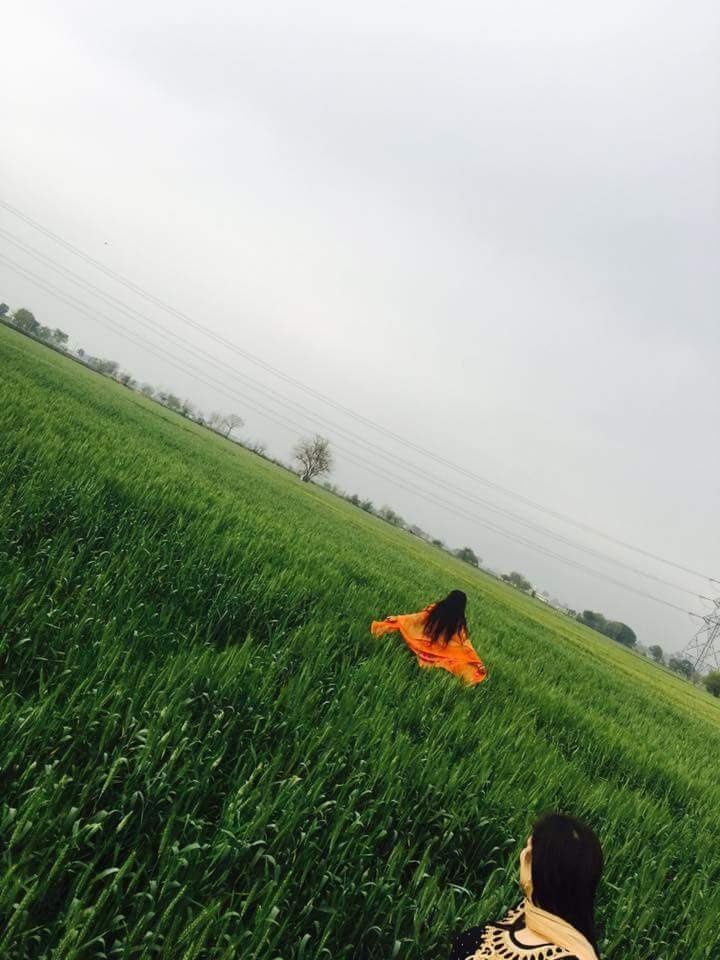Most Likely to Be Diagnosed & Most Likely to Be Left out the Spotlight
Hiding in Plain Sight – Asian Women and Endometriosis by Nikita Aashi Chadha

*This article has been edited at a later date as my Endometriosis definitions were incorrect and outdated*
Yes, this condition is so underrepresented and underresearched that most explanations of Endometriosis are scientifically inaccurate.
I want to start this article by alluding to a previous one (https://cysters.org/use-it-or-lose-it-white-privilege-and-the-dangers-of-a-single-story/).
Last year, I wrote about the prevalence of white privilege within the reproductive health space, and the dangers that come with only displaying one side of the story. This article acts as a follow up to the previous; I’m going to discuss why it’s important for brown and black voices to be seen as true advocates of reproductive and mental health conditions. Intersectional feminist theory is based on the premise that our identities are dynamic. We have multiple layers of who we are that will intersect or interlock in our daily lives, determining the levels of oppression we may face. They span across gender, sexuality, class, race, ability (as a starting point, there are other intersections not included like nationality and religion). This needs to be understood when it concerns women of colour – as we don’t only face inherent bias through racism, but also because of patriarchy and misogyny. These concepts can’t be separated, and we generally find ourselves caught between the two. My last article on this topic addressed it through the lens of reproductive health in its entirety, but I want to focus on a specific illness this time… Endometriosis.
Endometriosis is a disease that disrupts the endocrine system – this is responsible for our hormonal health amongst other things. Scientifically, it is known to be an illness that inflames the body, plays havoc with our immune system, central nervous system, digestive process… I could go on. Lining similar to (but pathologically different from) the uterus lining finds its way to other parts of your body. Those cells can form lesions, as they have their own blood supply. Whilst Endometriosis is typical within the pelvic region (pelvis, bladder, bowels, rectum or uterosacral area – where the lower back meets the uterus), they have found the cells in every part of the human body (even the brain, the spleen, the lungs). Not only does Endometriosis refer to the wayward cells in the body, but it is characterised by the body’s inflammatory response, which triggers the central nervous and immune system function.
Scientists and doctors alike have theories for the cause, mainly being retrograde menstruation. That seems unlikely to me seeing as the cells are pathologically different from the uterus lining. I’ve never been offered an explanation for this disease that rules my life, and I don’t think I will ever have one that is entirely accurate in my lifetime.
It appears that Endometriosis is not a disease that acts quickly, most of us that have it have suffered with symptoms for years – some of which we wouldn’t even naturally associate with the disease. If you’ve been dealing with debilitating menstrual cramps, brain fog, fatigue, and muscle weakness – these are all typical signs of the disease and ones that are generally attributed to menstruation and seen as normal. It is not normal to be in excruciating pain during the menstrual process, despite what anyone tells you. It should not be an accepted standard that comes with being female or someone who bleeds.
I started to research the illness myself after realising that no doctor or specialist I had encountered – even the one who diagnosed me and performed my laparoscopy – had never really told me in simple terms what Endometriosis was, and what my life would be like now I’d been diagnosed. What I’ve found out during my research has both terrified and liberated me in a host of ways. I think if you’re going to battle something for the rest of your life, with no cure in sight… you should at least be aware of how you may have gotten this in the first place and what lifestyle changes could be made to alleviate the symptoms. Just to reiterate again, nothing I know about Endometriosis was taught to me by a doctor. After years of being told to not use the internet to diagnose yourself, I have found the internet, online communities and research papers to be my saving grace. Delving into the realms of chronic illness is difficult and not something that should be taken lightly. This topic triggers me to no end, and I have to take small steps each day rather than tackle the issue as a whole. This works for me – it may not work for you. Each endo sufferer is different, and we are not a monolith.
I find the debate on the causes of Endometriosis interesting, as we often see retrograde menstruation named as the culprit. This conveniently ignores the countless amount of studies and papers on the link between exposure to dioxins and the prevalence of Endometriosis. Dioxins are highly poisonous chemicals, which can be released during a chemical process i.e. the burning of fossil fuels. Dioxins are present in the soil used to grow our food, and the very air we breathe. High concentrations of dioxins enter the food chain via the consumption of animal products and fats. Over 90% of human consumption of dioxins comes through foods; dairy, meat, fish and shellfish. Funnily enough though, when treating or looking at Endometriosis – not one specialist has ever mentioned diet. When I requested a dietitian through the NHS about a month ago, I was told that they don’t fund that type of treatment for the illness I have… despite there being actual scientific studies that evidence exposure to dioxins to the prevalence of the disease within animal test subjects. The medical system within this country fails to take a holistic approach to understand this disease, and it shows. Anyone who is remotely trained in nutrition knows that you are what you eat, especially if you are chronically ill. Instead of focusing on causes and origins, doctors seem happy to patch the issue with pharmaceuticals to treat our symptoms. If you’re lucky, you’ll find a solution this way. If you’re not, you may end up misdiagnosed, given the wrong medication and then left to deal with a host of side effects or symptoms.
But, I digress and will bring us back to the topic of today – the prominence of white narratives and understanding Endometriosis. I have asked you previously to close your eyes and imagine the individuals we know that are associated with this disease. They are never Asian (unless you are a close friend of mine, and I have beaten you to death with this subject) and that is worrying to me as a young, Asian woman. Not only because it impedes the collective psyche of Asian women and our narratives, but because actually – scientifically, it has been proven that you are twice as likely to be diagnosed with Endometriosis as an Asian woman than a white woman. And interestingly enough, if you are white, you are 50% more likely to be diagnosed than if you are black (Black women are more likely to be diagnosed with Pelvic Inflammatory Disease, which is closely linked to sexual health and ideas around black female sexuality. Medical and societal bias definitely play a part in the low diagnosis rate)
It is worth noting that in this instance I have said women, and not individuals, in reference to the studies that are at the end of the article. The studies include diagnosis rates from those who were assigned female at birth and identify that way. It is understood by Cysters generally, and me personally, that not only those who identify as female can suffer from Endometriosis.
Imagine my surprise, having already written a piece about how damaging it is to show only white portrayals of this disease, to find these studies through a simple Google search. This is something that has been studied pre-1990 and continues to this day, and that most Asian women aren’t even aware of. I know I wasn’t. And yet here it was, as black and white as it could be:
“Women of Filipino (p < 0.01), Indian (p < 0.01), Japanese (p < 0.01), and Korean (p < 0.05) origin specifically were more likely to have endometriosis than Caucasian women” – https://www.ncbi.nlm.nih.gov/pubmed/28417349
“Clinical pregnancy rates were significantly lower for Asian women, specifically in Indian (p < 0.05), Japanese (p < 0.05), and Korean (p < 0.05) women, compared to Caucasian women, even after controlling for endometriosis status.” – https://www.ncbi.nlm.nih.gov/pubmed/28417349
“The risk of endometriosis has been linked to ethnicity and several studies have reported a nine-fold increase in risk in Asian women when compared to the European-American white female population” – https://reproductive-health-journal.biomedcentral.com/articles/10.1186/s12978-018-0506-7
I immediately felt both validated and confused. Why wasn’t this common knowledge given all the exposure Endometriosis has had within the media? Why were the women being shown on the mainstream BBC, all-white – whilst women of colour were only highlighted on fringe shows like the BBC Asian Network? I’m not saying that we should immediately only showcase Asian stories of Endometriosis, of course not – but what I am saying is if we are more likely to develop this disease than you are; you could at least invite us to the table and allow us to showcase our experiences. This works two-fold in this instance; Asian women, I need you to come together, raise your voices and defy the cultural shame and stigma that may stop you from speaking out about this. White women, I need you to de-centre yourselves and share your platforms with women who do not look like and do not reap the same privileges you do. This is not specific just to Asian women but should encompass all women of colour. I have yet to see a black woman speaking publicly about her experiences of Endometriosis or any other reproductive health issue in the mainstream media. Media exposure, like feminism, needs to be intersectional or it is not inclusive.
I don’t know if what I’m suggesting is even possible. From working with Cysters, I’ve learnt first-hand that I’m very privileged as a British Asian. I don’t fear the same ostracism or backlash when I speak publicly about my illness and how it affects my life – I even spoke candidly about how Endometriosis has affected my sex life on a live radio show. Being a second-generation diaspora child has allowed me that privilege of being less connected to my culture, its subsequent community and therefore the shame that comes with it. Whiteness is also allowed this privilege – in a way that brown women are not – because of the cultural differences. I’m not asking you to not step into the spotlight concerning this illness if you’re white – I’m just asking that you try to find another way to bring us into the picture too. We are more likely than you, to develop this disease, but less likely to be represented within the media and this needs to be addressed.
I’d like to take this opportunity to challenge this space, the influencers who profit from the movement and the organisations who are seen as thought leaders to actively challenge what they already know about the disease and to start to hand part of their mantle, and their power to the demographic who is twice as likely to suffer from the illness than they are. To unsettle the narrative that only one type of woman is worth listening to, is worth giving the spotlight to, or indeed is worth saving more than the other.
I could write about this topic for days, and I will return to it when I’m less triggered. There are some resources for you here:
https://www.contemporaryobgyn.net/endometriosis/how-raceethnicity-influences-endometriosis
https://www.ncbi.nlm.nih.gov/pmc/articles/PMC5445055/
https://www.ncbi.nlm.nih.gov/pubmed/28417349
https://www.healthxchange.sg/women/urology/endometriosis-asian-women-higher-risk
https://obgyn.onlinelibrary.wiley.com/doi/full/10.1111/1471-0528.15805
https://bmcwomenshealth.biomedcentral.com/articles/10.1186/1472-6874-12-9
https://reproductive-health-journal.biomedcentral.com/articles/10.1186/s12978-018-0506-7
https://www.asianscientist.com/2015/05/in-the-lab/link-sex-endometriosis/



